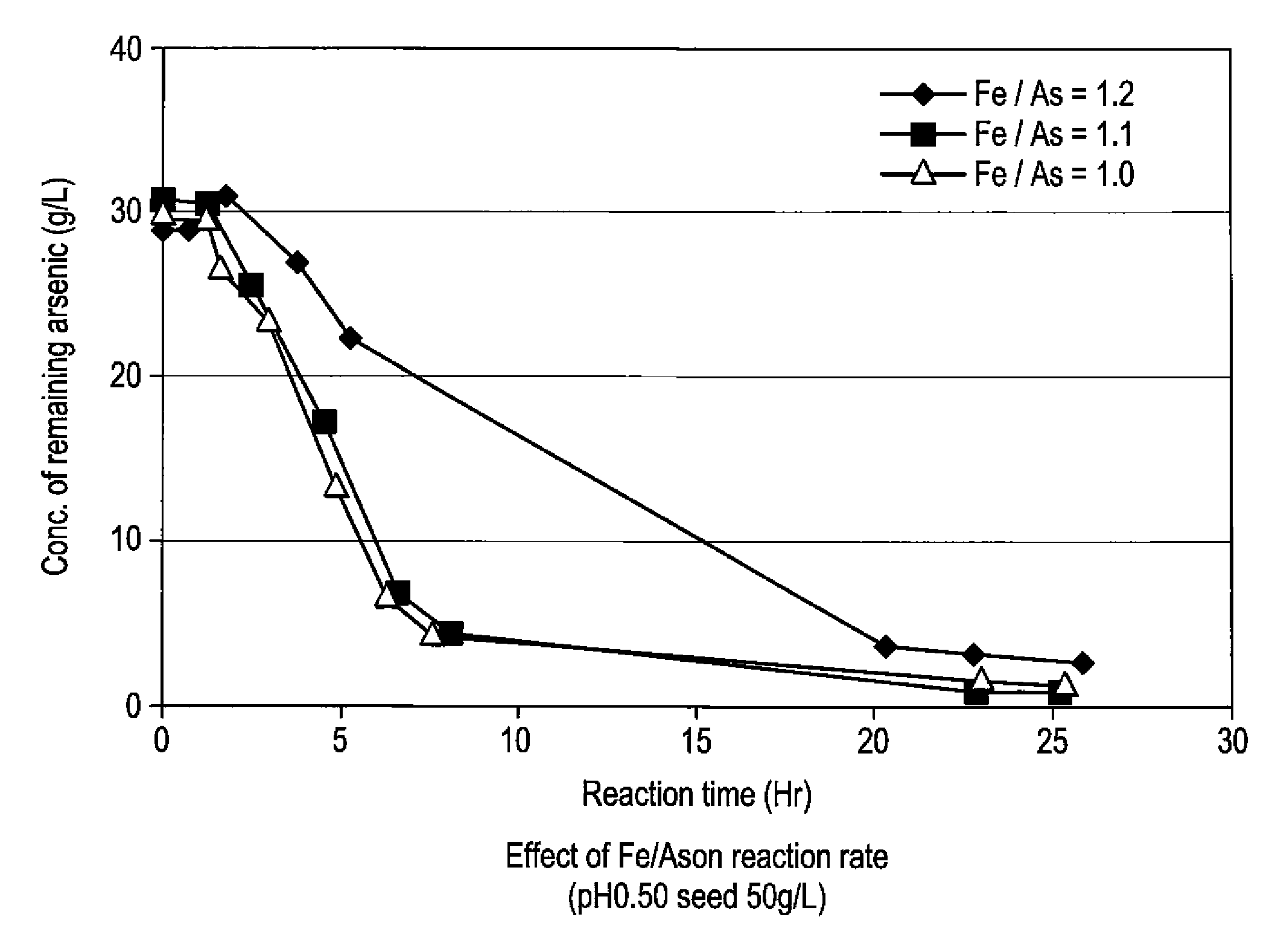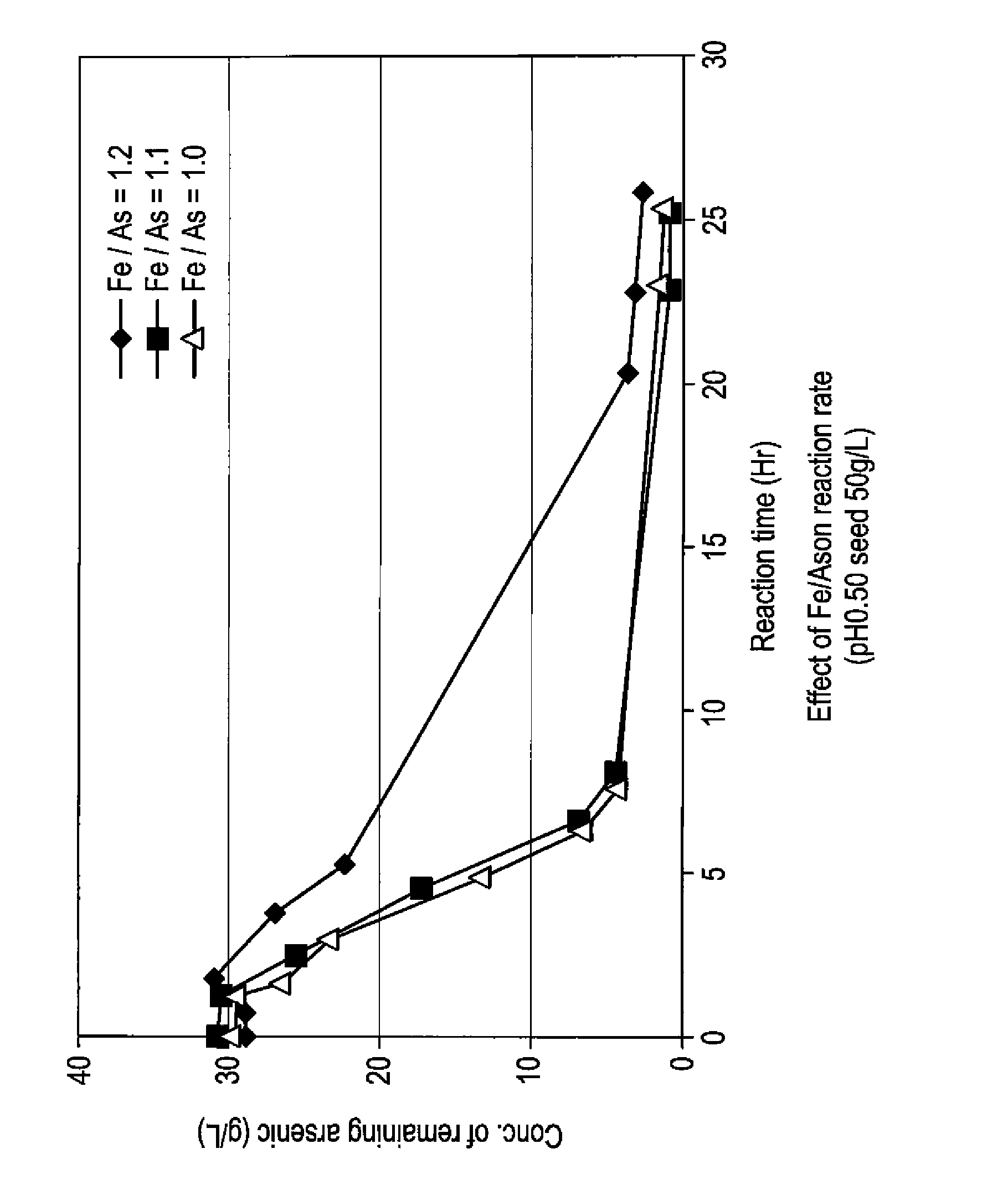Process for producing scorodite and recycling the post-scorodite-synthesis solution
a post-scorodite and synthesis solution technology, applied in the field of scorodite production, can solve the problems of lack of stability and unsuitability for long-term storage, and achieve the effect of improving the yield of arsenic and iron and shortening the time required for synthesizing
- Summary
- Abstract
- Description
- Claims
- Application Information
AI Technical Summary
Benefits of technology
Problems solved by technology
Method used
Image
Examples
working example
Example 1
[0059]To 5 L of sulfuric acid-leached solution of an electrolytically precipitated copper (pH 0.98, the preparation method thereof being described elsewhere), 3.3 L of water and 1.5 L of polyferric sulfate sold by Nittetsu Kogyo Corp. (also referred to as “poly-iron”, hereafter) were added, and then pH thereof was adjusted to 0.5 with 0.3 L of 400 g / L sulfuric acid (1.1 equivalent of ferric iron based on arsenic). Finally, as a seed crystal, 500 g of crystalline scorodite was added. Subsequently, the solution was heated to 95° C. while it was concentrated again to 10 L, and synthesis of scorodite was performed for 24 hours. During the heating, in order to avoid the situation where the amount of the solution decreases too much by evaporation, water was appropriately added so that the amount of the solution may be kept at 10 L. The reaction did not progress immediately after the sulfuric acid-leached solution and ferric sulfate solution were mixed at room temperature. With he...
example 2
[0066]To 5 L of sulfuric acid-leached solution of electrolytically precipitated copper (pH 1.04, process for producing it being described in Example 1), 3.2 L of water and 1.37 L of polyferric sulfate (also referred to as “poly-iron”, hereafter) available from Nittetsu Kogyo Corp. were added, and then pH was adjusted to 0.5 with 0.390 L of 400 g / L sulfuric acid (1 equivalent of the ferric based on the arsenic). Finally, as a seed crystal, 500 g (dry weight) of crystalline scorodite was added. Subsequently, the solution was heated to 95° C. while it was adjusted again to 10 L, and synthesis of scorodite was performed for 24 hours. During the heating, in order to avoid the situation where the amount of the solution decreases too much by evaporation, water was appropriately added so that the amount of the solution may be kept at 10 L. Just after mixing the sulfuric acid-leached solution with the ferric sulfate solution at a room temperature, the reaction did not take place. With heatin...
example 3
[0069]To 4.77 L of sulfuric acid-leached solution of electrolytically precipitated copper (pH 1.07, process for producing it being described in Example 1), 3 L of water and 1.26 L of polyferric sulfate (also referred to as “poly-iron”, hereafter) available from Nittetsu Kogyo Corp. were added, and then pH was adjusted to 0.5 with 0.345 L of 400 g / L sulfuric acid (0.97 equivalent of the ferric based on the arsenic). Finally, as a seed crystal, 480 g (dry weight) of crystalline scorodite was added. Subsequently, the solution was heated to 95° C. while it was adjusted again to 9.6 L, and synthesis of scorodite was performed for 24 hours. During the heating, in order to avoid the situation where the amount of the solution decreases too much by evaporation, water was appropriately added so that the amount of the solution may be kept to 9.6 L. Just after mixing the sulfuric acid-leached solution with the ferric sulfate solution at a room temperature, the reaction did not take place. With ...
PUM
| Property | Measurement | Unit |
|---|---|---|
| molar ratio | aaaaa | aaaaa |
| temperature | aaaaa | aaaaa |
| temperature | aaaaa | aaaaa |
Abstract
Description
Claims
Application Information
 Login to View More
Login to View More - R&D
- Intellectual Property
- Life Sciences
- Materials
- Tech Scout
- Unparalleled Data Quality
- Higher Quality Content
- 60% Fewer Hallucinations
Browse by: Latest US Patents, China's latest patents, Technical Efficacy Thesaurus, Application Domain, Technology Topic, Popular Technical Reports.
© 2025 PatSnap. All rights reserved.Legal|Privacy policy|Modern Slavery Act Transparency Statement|Sitemap|About US| Contact US: help@patsnap.com



